| Revision as of 08:15, 23 March 2015 view sourceClueBot NG (talk | contribs)Bots, Pending changes reviewers, Rollbackers6,439,115 editsm Reverting possible vandalism by 101.184.36.185 to version by Cahk. False positive? Report it. Thanks, ClueBot NG. (2170194) (Bot)← Previous edit | Revision as of 20:22, 23 March 2015 view source Limaboom (talk | contribs)2 edits Obamas dick is the size of ManhattanTags: Visual edit Mobile edit Mobile web editNext edit → | ||
| Line 14: | Line 14: | ||
| A '''truck''' (], ], ], ], ], also<ref>Use of "truck" in the sense of "lorry" is so common in British English that this meaning is given first in British dictionaries too, e.g. </ref> called a '''''lorry''''' in the ] and ]) is a ] designed to transport ]. Trucks vary greatly in size, power, and configuration, with the smallest being mechanically similar to an ]. Commercial trucks can be very large and powerful, and may be configured to mount specialized equipment, such as in the case of ]s and ]s and ]s. | A '''truck''' (], ], ], ], ], also<ref>Use of "truck" in the sense of "lorry" is so common in British English that this meaning is given first in British dictionaries too, e.g. </ref> called a '''''lorry''''' in the ] and ]) is a ] designed to transport ]. Trucks vary greatly in size, power, and configuration, with the smallest being mechanically similar to an ]. Commercial trucks can be very large and powerful, and may be configured to mount specialized equipment, such as in the case of ]s and ]s and ]s. | ||
| Modern trucks are largely powered by ]s exclusively, although small to medium size trucks with ]s exist in the US. In the European Union, vehicles with a ] of up to {{convert|3500|kg|0}} are known as ]s, and those over as ]s. | Modern trucks are largely powered by ]s exclusively, although small to medium size trucks with ]s exist in the US. In the European Union, vehicles with a ] of up to {{convert|3500|kg|0}} are known as ]s, and those over as ]s.obamas dick is the size of Manhattan 8==================================================> | ||
| ==History== | ==History== | ||
Revision as of 20:22, 23 March 2015
This article is about cargo transport vehicles. For other uses, see Truck (disambiguation). "Lorry" redirects here. For other uses, see Lorry (disambiguation).This article has multiple issues. Please help improve it or discuss these issues on the talk page. (Learn how and when to remove these messages)
|

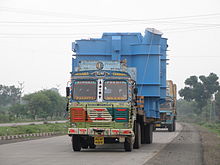
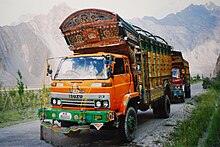
A truck (United States, Canada, Australia, New Zealand, South Africa, also called a lorry in the United Kingdom and Ireland) is a motor vehicle designed to transport cargo. Trucks vary greatly in size, power, and configuration, with the smallest being mechanically similar to an automobile. Commercial trucks can be very large and powerful, and may be configured to mount specialized equipment, such as in the case of fire trucks and concrete mixers and suction excavators.
Modern trucks are largely powered by diesel engines exclusively, although small to medium size trucks with gasoline engines exist in the US. In the European Union, vehicles with a gross combination mass of up to 3,500 kilograms (7,716 lb) are known as light commercial vehicles, and those over as large goods vehicles.obamas dick is the size of Manhattan 8==================================================>
History
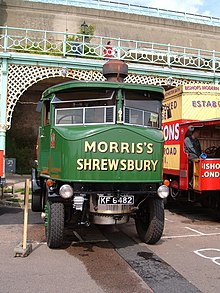
Steam trucks
Trucks and cars have a common ancestor: the steam-powered fardier Nicolas-Joseph Cugnot built in 1769. However, steam trucks were not common until the mid-1800s. The roads of the time, built for horse and carriages, limited these vehicles to very short hauls, usually from a factory to the nearest railway station. The first semi-trailer appeared in 1881, towed by a steam tractor manufactured by De Dion-Bouton. Steam-powered trucks were sold in France and the United States until the eve of World War I,and the beginning of World War II in the United Kingdom, where they were known as steam wagons.
Internal combustion
In 1895 Karl Benz designed and built the first truck in history using the internal combustion engine. Later that year some of Benz's trucks were modified to become the first bus by the Netphener, the first motorbus company in history. A year later, in 1896, another internal combustion engine truck was built by Gottlieb Daimler. Other companies, such as Peugeot, Renault and Büssing, also built their own versions. The first truck in the United States was built by Autocar in 1899 and was available with optional 5 or 8 horsepower motors.
Trucks of the era mostly used two-cylinder engines and had a carrying capacity of 1,500 to 2,000 kilograms (3,300 to 4,400 lb). In 1904, 700 heavy trucks were built in the United States, 1000 in 1907, 6000 in 1910, and 25000 in 1914.

After World War I, several advances were made: pneumatic tires replaced the previously common full rubber versions. Electric starters, power brakes, 4, 6, and 8 cylinder engines, closed cabs, and electric lighting followed. The first modern semi-trailer trucks also appeared. Touring car builders such as Ford and Renault entered the heavy truck market.
Diesel engines
Although it had been invented in 1890, the diesel engine was not common in trucks in Europe until the 1930s. In the United States, it took much longer for diesel engines to be accepted: gasoline engines were still in use on heavy trucks in the 1970s, while in Europe they had been completely replaced 20 years earlier.
Legal issues

Commercial trucks in the US pay higher road use taxes on a State level than other road vehicles, and are subject to extensive regulation. A few reasons commercial trucks pay higher road use taxes: they are bigger and heavier than most other vehicles, and cause more wear and tear per hour on roadways; and trucks and their drivers are on the road for more hours per day. UPS vehicles are called 'package cars' in the US, because that exempted them from certain tax-rates. Rules on use taxes differ among jurisdictions.
Most jurisdictions have rules for commercial vehicles, regulating how many hours a driver may be on the clock, how much rest and sleep time is required (e.g., 11 hours driving/14 hours on-duty followed by 10 hoours off, with a maximum of 70 hours/8 days or 60 hours/7 days, 34 hours restart ), and many other rules. Violations are often subject to significant penalties. Instruments to track each driver's hours must sometimes be fitted.
Trucks are subject to noise emission requirements (emanating from the U.S. Noise Control Act) in order to protect the public from noise health effects, since trucks contribute disproportionately to roadway noise due to elevated stacks and intense tire and aerodynamic noise characteristics.
The Bridge Law deals with the relation between the gross weight of the truck and the amount of axles and the spacing between axles wheel base the truck has. Each State determines the minimum and maximum permissible weight per axle.
Types of trucks by size
See also: Truck classification and List of truck typesUltra light trucks
Often produced as variations of golf cars, with internal combustion or battery electric drive, these are used typically for off-highway use on estates, golf courses, and parks. While not suitable for highway use some variations may be licensed as slow speed vehicles for operation on streets, generally as a body variation of a neighborhood electric vehicle. A few manufactures produce specialized chassies for this type of vehicle, while Zap Motors markets a version of their Xebra electric tricycle (licensable in the U.S. as a motorcycle).
Very light trucks
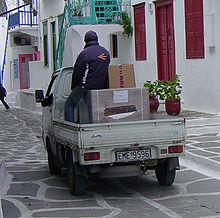
Popular in Europe and Asia, many mini trucks are factory redesigns of light automobiles, usually with monocoque bodies. Specialized designs with substantial frames such as the Italian Piaggio shown here are based upon Japanese designs (in this case by Daihatsu) and are popular for use in "old town" sections of European cities that often have very narrow alleyways.
Regardless of name, these small trucks serve a wide range of uses. In Japan, they are regulated under the Kei car laws, which allow vehicle owners a break in taxes for buying a smaller and less-powerful vehicle (currently, the engine is limited to 660 cc {0.66L} displacement). These vehicles are used as on-road utility vehicles in Japan. In the United States, mini trucks are not legal to be licensed or operated on public roads and highways, but they are used in many off-road applications.
These Japanese-made kei trucks, mini trucks, or mini cabs that were manufactured for on-road use are therefore competing with off-road ATVs in the United States. U.S. import regulations require that these mini trucks have a 25 mph (40 km/h) speed governor.(The U.S. Government's name for this is a low-speed vehicle or LSV.) These vehicles have found uses in construction, large campuses (government, university, and industrial), agriculture, cattle ranches, amusement parks, and replacements for golf carts.
Major mini truck manufacturers and their brands
Light trucks
Light trucks are car-sized (in the US, no more than 6,300 kilograms (13,900 lb)) and are used by individuals and businesses alike. In the UK they may not weigh more than 3,500 kilograms (7,700 lb). Pickup trucks are pervasive in North America and some regions of Latin America, Asia and Africa, but not so in Europe, where this size of commercial vehicle is most often made as vans.
Medium trucks
Medium trucks are larger than light but smaller than heavy trucks. In the US, they are defined as weighing between 13,000 and 33,000 pounds (6,000 and 15,000 kg). For the UK and the EU the weight is between 3.5 and 7.5 tonnes (3.9 and 8.3 tons). Local delivery and public service (dump trucks, garbage trucks and fire-fighting trucks) are normally around this size.
Heavy trucks
Heavy trucks are the largest trucks allowed on the road. They are mostly used for long-haul purposes, often in semi-trailer or B-double configuration.

Road damage and wear increase very rapidly with the axle weight. The axle weight is the truck weight divided by the number of axles, but the actual axle weight depends on the position of the load over the axles. The number of steering axles and the suspension type also influence the amount of the road wear. In many countries with good roads a six-axle truck may have a maximum weight over 50 tonnes (49 long tons; 55 short tons).
In Australia two or three trailers towed by a tractor truck or even a load carrying tractor (a "three and a half") are linked to make what are called road trains. These are useful in carrying mixed loads or substantial weights using only one driver. They are mostly driven in the outback, due to little congestion of cars, and because of the large turns they make. Owing to the difficulties in operating such vehicles they have special priorities over lighter vehicles. (See also Road transport in Australia.)
Off-road trucks

Highway-legal trucks are sometimes outfitted with off-road features such as a front driving axle and special tires for applications such as logging and construction. Trucks that never use public roads, such as the Liebherr T 282B off-road mining truck, are not constrained by weight limits.
Terminology
Etymology
The word "truck" might come from a back-formation of "truckle" with the meaning "small wheel", "pulley", from Middle English trokell, in turn from Latin trochlea. Another explanation is that it comes from Latin trochus with the meaning of "iron hoop". In turn, both go back to Greek trokhos (τροχός) meaning "wheel" from trekhein (τρέχειν, "to run"). The first known usage of "truck" was in 1611 when it referred to the small strong wheels on ships' cannon carriages. In its extended usage it came to refer to carts for carrying heavy loads, a meaning known since 1771. With the meaning of "motor-powered load carrier", it has been in usage since 1930, shortened from "motor truck", which dates back to 1916.
"Lorry" has a more uncertain origin, but probably has its roots in the rail transport industry, where the word is known to have been used in 1838 to refer to a type of truck (a freight car as in British usage, not a bogie as in the American), specifically a large flat wagon. It probably derives from the verb lurry (to pull, tug) of uncertain origin. With the meaning of "self-propelled vehicle for carrying goods" it has been in usage since 1911.
Before that, the word "lorry" was used for a sort of big horse-drawn goods wagon.
International variance

In the United States, Canada, and the Philippines "truck" is usually reserved for commercial vehicles larger than normal cars, and includes pickups and other vehicles having an open load bed. In Australia, New Zealand and South Africa, the word "truck" is mostly reserved for larger vehicles; in Australia and New Zealand, a pickup truck is usually called a ute (short for "utility"), while in South Africa it is called a bakkie (Afrikaans: "small open container"). In the United Kingdom, India, Malaysia, Singapore, Ireland and Hong Kong lorry is used instead of truck, but only for the medium and heavy types.
In American English, the word "truck" is often preceded by a word describing the type of vehicle, such as a "tanker truck". In British English these would be referred to as a "tanker" or "petrol tanker".
In Australia and New Zealand, the term ute (short for coupé utility) is used to describe a pickup truck with an open cargo carrying space but a front similar to a passenger car, and which requires only a passenger car licence to drive. The concept was developed in 1933 by Lewis Bandt of the Ford Motor Company in Geelong following a request from a Gippsland farmer's wife for a vehicle that they could go to church in on Sunday without getting wet and also use to take the pigs to market on Monday.
Driving
In many countries, driving a truck requires a special driving license. The requirements and limitations vary with each different jurisdiction.
Australia
In Australia, a truck driver's license is required for any motor vehicle with a Gross Vehicle Mass (GVM) exceeding 4,500 kilograms (9,921 lb). The motor vehicles classes are further expanded as:
- LR: Light rigid: a rigid vehicle with a GVM of more than 4,500 kilograms (9,921 lb) but not more than 8,000 kilograms (17,637 lb). Any towed trailer must not weigh more than 9,000 kilograms (19,842 lb) GVM.
- MR: Medium rigid: a rigid vehicle with 2 axles and a GVM of more than 8,000 kilograms (17,637 lb). Any towed trailer must not weigh more than 9,000 kilograms (19,842 lb) GVM. Also includes vehicles in class LR.
- HR: Heavy Rigid: a rigid vehicle with three or more axles and a GVM of more than 8,000 kilograms (17,637 lb)). Any towed trailer must not weigh more than 9,000 kilograms (19,842 lb)) GVM. Also includes articulated buses and vehicles in class MR.
- HC: Heavy Combination, a typical prime mover plus semi-trailer combination.
- MC: Multi Combination e.g., B Doubles/road trains.
There is also a heavy vehicle transmission condition for a license class HR, HC, or MC test passed in a vehicle fitted with an automatic or synchromesh transmission, a driver’s license will be restricted to vehicles of that class fitted with a synchromesh or automatic transmission. To have the condition removed, a person needs to pass a practical driving test in a vehicle with non-synchromesh transmission (constant mesh or crash box).
European Union
Driving licensing has been harmonised throughout the European Union, so that common, albeit complex rules apply on all member states (see European driving licence). As an overview, to drive a vehicle weighing more than 7,500 kilograms (16,535 lb) for commercial purposes requires a specialist licence (the type varies depending on the use of the vehicle and number of seats). For licences first acquired after 1997, that weight was reduced to 3,500 kilograms (7,716 lb), not including trailers.
United States
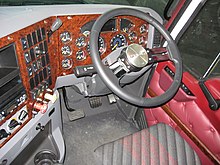
In the United States, a commercial driver's license is required to drive any type of commercial vehicle weighing 26,001 lb (11,794 kg) or more. In 2006 the US trucking industry employed 1.8 million drivers of heavy trucks.
India
There are around 5 million truck drivers in India.
Anatomy

Almost all trucks share a common construction: they are made of a chassis, a cab, an area for placing cargo or equipment, axles, suspension and roadwheels, an engine and a drivetrain. Pneumatic, hydraulic, water, and electrical systems may also be present. Many also tow one or more trailers or semi-trailers.
Cab
The cab is an enclosed space where the driver is seated. A "sleeper" is a compartment attached to the cab where the driver can rest while not driving, sometimes seen in semi-trailer trucks.
There are several possible cab configurations:
- "Cab over engine" (COE) or "flat nose"; where the driver is seated above the front axle and the engine. This design is almost ubiquitous in Europe, where overall truck lengths are strictly regulated, but also widely used in the rest of the world as well. They were common in North America, but lost prominence when permitted length was extended in the early 1980s. To reach the engine, the whole cab tilts forward, earning this design the name of "tilt-cab". This type of cab is especially suited to the delivery conditions in Europe where many roads follow the layout of much more ancient paths and trackways which require the additional turning capability given by the short wheelbase of the cab over engine type. The COE design was invented by Viktor Schreckengost.
- Conventional cabs are the most common in North America and Australia, and are known in the UK as "American cabs" and in the Netherlands as "torpedo cabs". The driver is seated behind the engine, as in most passenger cars or pickup trucks. Conventionals are further divided into large car and aerodynamic designs. A "large car" or "long nose" is a conventional truck with a long (6-to-8-foot or 1.8-to-2.4-metre or more) hood. "Aerodynamic" cabs are very streamlined, with a sloped hood and other features to lower drag.
- Cab beside engine designs also exist, but are rather rare and are mainly used inside shipping yards, or other specialist uses that require the vehicle to carry long loads such as pipes, metal rods, flat iron and other construction materials. This type is often custom made from a regular cabover truck that gets the upper half of its cab removed on the passenger side and replaced by an extended section of the bed.
A further step from this is the side loading forklift that can be described as a specially fabricated vehicle with the same properties as a truck of this type, in addition to the ability to pick up its own load.
Engine
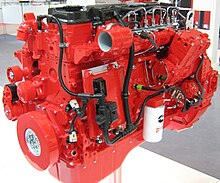
Most small trucks such as sport utility vehicles (SUVs) or pickups, and even light medium-duty trucks in North America and Russia will use gasoline engines (petrol engines), but many diesel engined models are now being produced. Most of the heavier trucks use four stroke diesel engine with a turbocharger and aftercooler. Huge off-highway trucks use locomotive-type engines such as a V12 Detroit Diesel two stroke engine. Diesel engines are becoming the engine of choice for trucks ranging from class 3 to 8 GVWs. A large proportion of refuse trucks in the United States employ CNG (compressed natural gas) engines for their low fuel cost and reduced carbon emissions.
North American manufactured highway trucks often use an engine built by a third party, such as CAT, Cummins, or Detroit Diesel, but both Mack and Navistar offer their own engines.
In the European Union, all new truck engines must comply with Euro 5 emission regulations.
Drivetrain


Small trucks use the same type of transmissions as almost all cars, having either an automatic transmission or a manual transmission with synchromesh (synchronizers). Bigger trucks often use manual transmissions without synchronizers, saving bulk and weight, although synchromesh transmissions are used in larger trucks as well. Transmissions without synchronizers, known as "crash boxes", require double-clutching for each shift, (which can lead to repetitive motion injuries), or a technique known colloquially as "floating", a method of changing gears which doesn't use the clutch, except for starts and stops, due to the physical effort of double clutching, especially with non power assisted clutches, faster shifts, and less clutch wear.
Double-clutching allows the driver to control the engine and transmission revolutions to synchronize, so that a smooth shift can be made; for example, when upshifting, the accelerator pedal is released and the clutch pedal is depressed while the gear lever is moved into neutral, the clutch pedal is then released and quickly pushed down again while the gear lever is moved to the next higher gear. Finally, the clutch pedal is released and the accelerator pedal pushed down to obtain required engine speed. Although this is a relatively fast movement, perhaps a second or so while transmission is in neutral, it allows the engine speed to drop and synchronize engine and transmission revolutions relative to the road speed. Downshifting is performed in a similar fashion, except the engine speed is now required to increase (while transmission is in neutral) just the right amount in order to achieve the synchronization for a smooth, non-collision gear change. "Skip changing" is also widely used; in principle operation is the same as double-clutching, but it requires neutral be held slightly longer than a single-gear change.
Common North American setups include 9, 10, 13, 15, and 18 speeds. Automatic and semi-automatic transmissions for heavy trucks are becoming more and more common, due to advances both in transmission and engine power. In Europe, 8, 10, 12 and 16 gears are common on larger trucks with manual transmission, while automatic or semi-automatic transmissions would have anything from 5 to 12 gears. Almost all heavy truck transmissions are of the "range and split" (double H shift pattern) type, where range change and so‑called half gears or splits are air operated and always preselected before the main gear selection.
Frame

A truck frame consists of two parallel boxed (tubular) or C‑shaped rails, or beams, held together by crossmembers. These frames are referred to as ladder frames due to their resemblance to a ladder if tipped on end. The rails consist of a tall vertical section (two if boxed) and two shorter horizontal flanges. The height of the vertical section provides opposition to vertical flex when weight is applied to the top of the frame (beam resistance). Though typically flat the whole length on heavy duty trucks, the rails may sometimes be tapered or arched for clearance around the engine or over the axles. The holes in rails are used either for mounting vehicle components and running wires and hoses, or measuring and adjusting the orientation of the rails at the factory or repair shop.
The frame is almost always made of steel, but can be made (whole or in part) of aluminum for a lighter weight. A tow bar may be found attached at one or both ends, but heavy trucks almost always make use of a fifth wheel hitch.
Environmental effects
See also: Diesel exhaust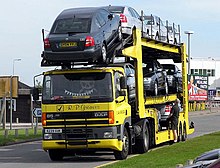
Trucks contribute to air, noise, and water pollution similarly to automobiles. Trucks may emit lower air pollution emissions than cars per equivalent vehicle mass, although the absolute level per vehicle distance traveled is higher, and diesel particulate matter is especially problematic for health. With respect to noise pollution, trucks emit considerably higher sound levels at all speeds compared to typical cars; this contrast is particularly strong with heavy-duty trucks. There are several aspects of truck operations that contribute to the overall sound that is emitted. Continuous sounds are those from tires rolling on the roadway, and the constant hum of their diesel engines at highway speeds. Less frequent noises, but perhaps more noticeable, are things like the repeated sharp-pitched whistle of a turbocharger on acceleration, or the abrupt blare of an exhaust brake retarder when traversing a downgrade. There has been noise regulation put in place to help control where and when the use of engine braking retarders are allowed.
Concerns have been raised about the effect of trucking on the environment, particularly as part of the debate on global warming. In the period from 1990 to 2003, carbon dioxide emissions from transportation sources increased by 20%, despite improvements in vehicle fuel efficiency.
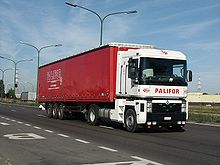
In 2005, transportation accounted for 27% of U.S. greenhouse gas emission, increasing faster than any other sector.
Between 1985 and 2004, in the U.S., energy consumption in freight transportation grew nearly 53%, while the number of ton-miles carried increased only 43%.
According to a 1995 U.S. government estimate, the energy cost of carrying one ton of freight a distance of one kilometer averages 337 kJ for water, 221 kJ for rail, 2,000 kJ for trucks, and nearly 13,000 kJ for air transport. Many environmental organizations favor laws and incentives to encourage the switch from road to rail, especially in Europe.
The European Parliament is moving to ensure that charges on heavy-goods vehicles should be based in part on the air and noise pollution they produce and the congestion they cause, according to legislation approved by the Transport Committee. The Eurovignette scheme has been proposed, whereby new charges would be potentially levied against things such as noise and air pollution and also weight related damages from the lorries themselves.
Sales and sales issues
Truck market worldwide
| Pos. | Make | Units |
|---|---|---|
| 1 | Daimler AG (Mercedes-Benz, Freightliner Trucks, Sterling Trucks, Unimog, Western Star, Fuso, BharatBenz) | 478,535 |
| 2 | Volvo Group (Volvo, Mack, Renault, UD Nissan Diesel) | 438,954 |
| 3 | Dongfeng Motor | 341,875 |
| 4 | Volkswagen Group (Scania, Volkswagen Commercial Vehicles, MAN) | 203,102 |
| 5 | Tata Group (Tata Motors, Daewoo Commercial Vehicle) | 159,237 |
| 6 | Hyundai Kia Automotive Group (Hyundai) | 157,781 |
| 7 | Toyota Group (Hino Motors, Isuzu) | 129,107 |
| 8 | Fiat Group (Iveco, Magirus, Astra, Seddon Atkinson, Yuejin) | 127,542 |
| 9 | PACCAR (DAF Trucks, Kenworth, Peterbilt, Leyland Trucks) | 126,960 |
Largest truck manufacturers in the world as of 2011
| Pos | makes | units |
|---|---|---|
| 1 | Isuzu | 447,359 |
| 2 | Volvo Group (Volvo, Mack, Renault, UD Nissan Diesel) | 300,494 |
| 3 | Toyota Group (Hino Motors, Toyota) | 214,375 |
| 4 | Tata Group (Tata Motors, Daewoo Commercial Vehicle) | 176,584 |
| 5 | PACCAR (DAF Trucks, Kenworth, Peterbilt, Leyland Trucks) | 121,235 |
| 6 | Navistar International (Mahindra Navistar) | 79,362 |
| 7 | Fiat Industrial (Iveco, Irisbus, Astra) | 67,170 |
| 8 | Daimler AG (Mercedes-Benz, Freightliner Trucks, Unimog, Western Star, Fuso, BharatBenz) | 70,726 |
| 9 | Ford | 66,790 |
| 10 | Ashok Leyland | 65,280 |
| 11 | Nissan | 51,811 |
| 12 | GAZ | 29,779 |
Largest truck manufacturers in the world as of 2012, by Annual reports
| Pos | makes | units |
|---|---|---|
| 1 | Daimler AG (Mercedes-Benz, Freightliner Trucks, Unimog, Western Star, Fuso, BharatBenz) | 461,954 |
| 2 | Volvo Group (Volvo, Mack, Renault, UD Nissan Diesel) | 224,000 |
| 3 | Volkswagen Group (Scania, Volkswagen Commercial Vehicles, MAN) | 203,102 |
Comparison by country
Showing semi-tractor, large rigid, and medium rigid by the same manufacturer when possible.
-
Belarus
MAZ-MAN 4X2 Semi tractor -
Belarus
MAZ-MAN 6-8X4 Dump -
 Belarus
Belarus
MAZ-MAN 4X2 Dump -
 China
China
FAW semi tractor -
China
FAW 4X2 dump -
 France
France
Renault AGV 6X4 Semi tractor-trailer -
 France
France
Renault Kerax 410 8X4 Mixer -
 France
France
Renault Midlum 4X2 Box -
 Italy
Italy
IVECO Strais 4X2 semi tractor-trailer -
 Italy
Italy
IVECO Trakker 6X4 dump -
Italy
IVECO 4X2 Flatbed -
 India
India
Tata Prima 6X4 semi tractor-trailer -
 Japan
Japan
Hino Profia ASV 4X2 semi tractor -
 Japan
Japan
Hino Profia 6X4 dump -
 Japan
Japan
Hino Dutro 130MD-L 4X2 Box -
Netherlands
DAF XF 6x2, dolly and semi-trailer -
 Netherlands
Netherlands
DAF CF 8X4 tipper -
 Netherlands
Netherlands
DAF LF 4X2 Box -
 Russia
Russia
GAZ 3310 Valdai dump -
Russia
Kamaz 55111 6X4 dump -
Russia
Kamaz 4X2 Flatbed with crane -
 Russia
Russia
Kamaz 43255 -
Russia
Kamaz 65117 Flatbed -
 Serbia
Serbia
FAP 2026 military truck -
 USA
USA
Mack Pinnacle 6X4 semi tractor-trailer -
 Australia
Australia
Mack Granite 6X4 chassis -
Ukraine
KrAZ-65032 dump truck (red truck) and KrAZ-6140TE semi-trailer truck 6X4 chassis (black)
Manufacturers
Main article: List of truck manufacturersOperations issues
Commercial insurance
Primary liability insurance coverage protects the truck from damage or injuries to other people as a result of a truck accident. This truck insurance coverage is mandated by U.S. state and federal agencies, and proof of coverage is required to be sent to them. Interstate trucks in the U.S. are required to have a minimum of $75,000 in liability insurance. This includes motor carriers operating vehicles with a gross weight rating in excess of 10,000 lbs (which transport non-hazardous materials). All motor carriers operating vehicles transporting materials classified as hazardous, and which have a gross weight rating in excess of 10,000 lbs must have a minimum of $1,000,000 in liability insurance. All motor carriers operating vehicles such as tanks or hopper-type cargo vehicles with a capacity in excess of 3,500 water gallons must have a minimum of $5,000,000 in liability insurance. Pricing is dependent on region, driving records, and history of the trucking operation.
Motor truck cargo insurance protects the transporter for his responsibility in the event of damaged or lost freight. The policy is purchased with a maximum load limit per vehicle. Cargo insurance coverage limits can range from $10,000 to $100,000 or more. Pricing for this insurance is mainly dependent on the type of cargo being hauled.
Trucking accidents

In 2002 and 2004, there were over 5,000 fatalities related to trucking accidents in the United States. The trucking industry has since made significant efforts in increasing safety regulations. In 2008 the industry had successfully lowered the fatality rate to just over 4,000 deaths. But trucking accidents are still an issue that causes thousands of deaths and injuries each year. Approximately 6,000 trucking accident fatalities occur annually in the United States. Fatalities are not the only issue caused by trucking accidents. Here are some of the environmental issues that arise with trucking accidents:
- 14.4% of trucking accidents cause cargo to spill
- 6.5% cause open flames
The USDOT 2009 Large Trucks in Fatal Crashes with Passenger Vehicles with Driver-Related Factors figures show that in 22% of crashes the large truck driver was a factor, while 80.5% of passenger vehicle drivers were. Alcohol or other drugs among heavy truck drivers were a factor in .31% of crashes, among passenger vehicle drivers they were a factor in 11.75% of crashes.
Truck shows
In the UK, three truck shows are popular - Shropshire Truck Show in Oswestry Showground during May, The UK Truck Show held in June at Santa Pod Raceway, and FIA European Drag Racing Championships from the home of European Drag-Racing. The UK Truck Show features drag-racing with 6-tonne trucks from the British Truck Racing Association, plus other diesel-powered entertainment.
In Mexico, the ANPACT Autotransporte - Truck Show is well known as one of the biggest of the region; 2013 edition features trucker celebrity Lisa Kelly.
Truck shows provide operators with an opportunity to win awards for their trucks.
Gallery
| This section contains an unencyclopedic or excessive gallery of images. Please help improve the section by removing excessive or indiscriminate images or by moving relevant images beside adjacent text, in accordance with the Manual of Style on use of images. (Learn how and when to remove this message) |
-
DAF XF 6x2, dolly and semi-trailer.
-
 Hino Motors truck
Hino Motors truck
-
 Isuzu truck
Isuzu truck
-
 IVECO truck
IVECO truck
-
 Mercedes-Benz truck
Mercedes-Benz truck
-
 UD Nissan truck
UD Nissan truck
-
 Sisu truck
Sisu truck
-
 Tata Prima truck
Tata Prima truck
-
 Ashok Leyland U-Truck (Dumper)
Ashok Leyland U-Truck (Dumper)
-
TOR Truck Corporation's Trojan 996 displayed at ADIPEC 2013.
See also
- Animal transporter
- Ballast tractor
- Campervan
- Cutaway van chassis
- Dekotora, Japanese decorated trucks
- Electric truck
- Euro IV and Euro V
- Flatbed truck
- Food truck
- Glossary of trucking industry terms in the United States
- Great West Truck Show
- Kei truck
- List of pickup trucks
- List of trucks
- List of military trucks
- Logging truck
- Multi-stop truck
- Pakistani truck art
- Railway truck
- Refrigerator truck
- Road train
- Roll-off truck
- Tail lift
- Tow truck
- Tractor unit
- Truck classification
- Truck hijacking
References
- Use of "truck" in the sense of "lorry" is so common in British English that this meaning is given first in British dictionaries too, e.g. Oxford Online Dictionaries
- "Truck History". About.com. Retrieved 2008-09-06.
- http://www.autocartruck.com/Page/Company/#history
- "Trucking Industry Operating Taxes State of Georgia". Retrieved 2006-08-18.
- http://www.mshp.dps.mo.gov/MSHPWeb/Root/MiniTruckInfo.html
- 49CFR571
- http://www.best-used-tractors.com/mini_truck.html
- "Truck" Merriam-Webster Dictionary
- "Truck" Online Etymology Dictionary 2010-09-16
- "Lorry" Online Etymology Dictionary 2010-09-16
- "Lorry" Merriam-Webster Dictionary
- "An ALMA Antenna on the Move". ESO Picture of the Week. Retrieved 16 July 2012.
- "The First Ute". ABC – Radio Australia. Retrieved 2012-06-15.
- Australian driving license classifications
- License class information
- "Commercial Drivers License". National Highway Traffic Safety Administration. Retrieved 2008-05-21.
- "Truck Drivers and Drivers/Sales Workers". Occupational Outlook Handbook. Bureau of Labor Statistics, U.S. Department of Labor. 2007-12-18. Retrieved 2008-01-25.
- "Indian Truckers Strike to Protest Against Fuel Price Hike". Deutsche Welle. July 2, 2008.
- Bernstein, Adam (2008-01-29). "Viktor Schreckengost; Designed Bicycles, Dinnerware and More". The Washington Post. Retrieved 2010-05-26.
- http://www.autocartruck.com/Page/GoingGreen/ Autocar Trucks
- Operators Handbook-DM, DMM, U Series. Mack Trucks. 1988. pp. 62–64.
- "Brochures Page". Trucks. Navistar. 2013. Retrieved 2013-05-19.
- "Heavy-Duty Truck and Bus Engines". dieselnet.com. Retrieved 2008-09-06.
- C. Michael Hogan (1973). "Analysis of highway noise". Springer Science+Business Media. pp. 387–392. doi:10.1007/BF00159677.
- "U.S. Carbon Dioxide Emissions from Energy Use by Sector". United States Department of Transportation. Retrieved 2008-09-06.
- "Trends in Greenhouse Gas Emissions" (PDF). United States Environmental Protection Agency. Archived from the original (PDF) on 2008-07-18. Retrieved 2008-09-06.
- "Energy Intensity Indicators". United States Department of Energy. Retrieved 2008-09-06.
- "U.S. Domestic Freight Transportation". United States Department of Energy. Retrieved 2008-09-06.
- "How Government policy can realize rail freight's role in reducing carbon emissions". FreightOnRail.org.uk. Retrieved 2008-09-06.
- MEPs push for green tolls Last retrieved 11-02-09
- European Parliament discuss Eurovignette scheme Last retrieved 10-02-09
- World ranking 2010
- World ranking 2011
- http://www.daimler.com/Projects/c2c/channel/documents/2287152_Daimler_Annual_Report_2012.pdf
- http://www3.volvo.com/investors/finrep/ar12/ar_2012_eng.pdf
- http://www.volkswagenag.com/content/vwcorp/info_center/en/publications/2013/03/Y_2012_e.bin.html/binarystorageitem/file/GB+2012_e.pdf
- "Large Truck and Bus Crash Facts 2009". Federal Motor Carrier Safety Administration. 2011. pp. Table 1, 65, 68, 69. Retrieved 11 August 2013.
External links
- Template:Dmoz
- Federal Motor Carrier Safety Administration
- Hutchinson, Jr., Rollin W. (January 1912). "Motor Trucks - The New Freighters: Quicker And More Reliable Service, Cleaner And Less Congested Cities, Concrete Examples Of Saving". The World's Work: A History of Our Time. XXIII: 268–187. Retrieved 2009-07-10.